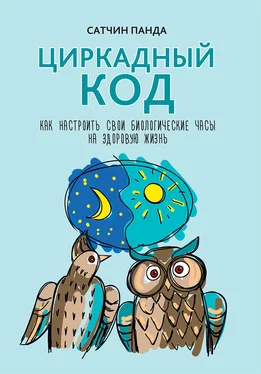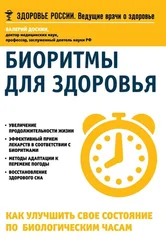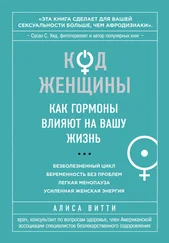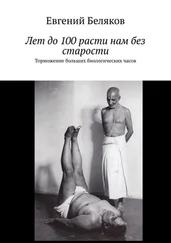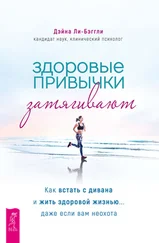13. K. Spiegel, J. F. Sheridan, and E. van Cauter, «Effect of Sleep Deprivation on Response to Immunization», JAMA: The Journal of the American Medical Association 288, no. 12 (2002): 1471—72.
14. J. E. Long et al., «Morning Vaccination Enhances Antibody Response over Afternoon Vaccination: A Cluster-Randomised Trial», Vaccine 34, no. 24 (2016): 2679—85.
15. O. Castanon-Cervantes, «Dysregulation of Inflammatory Responses by Chronic Circadian Disruption», Journal of Immunology 185, no. 10 (2010): 5796—805.
16. Y. M. Cissé et al., «Time-Restricted Feeding Alters the Innate Immune Response to Bacterial Endotoxin», Journal of Immunology 200, no. 2 (2018): 681—87.
17. J. Samulin Erdem et al., «Mechanisms of Breast Cancer Risk in Shift Workers: Association of Telomere Shortening with the Duration and Intensity of Night Work», Cancer Medicine 6, no. 8 (2017): 1988—97.
18. C. R. Marinac et al., «Prolonged Nightly Fasting and Breast Cancer Risk: Findings from NHANES (2009–2010)», Cancer Epidemiology, Biomarkers & Prevention 24, no. 5 (2015): 783—89.
19. E. Filipski et al., «Effects of Light and Food Schedules on Liver and Tumor Molecular Clocks in Mice», Journal of the National Cancer Institute 97, no. 7 (2005): 507—17.
20. M. W. Wu et al., «Effects of Meal Timing on Tumor Progression in Mice», Life Sciences 75, no. 10 (2004): 1181—93.
21. W. J. Hrushesky, «Circadian Timing of Cancer Chemotherapy», Science 228, no. 4695 (1985): 73–75.
22. R. Dallmann, A. Okyar, and F. Levi, «Dosing-Time Makes the Poison: Circadian Regulation and Pharmacotherapy», Trends in Molecular Medicine 22, no. 5 (2016): 430—35.
23. F. Levi et al., «Oxaliplatin Activity Against Metastatic Colorectal Cancer. A Phase II Study of 5-Day Continuous Venous Infusion at Circadian Rhythm Modulated Rate», European Journal of Cancer 29A, no. 9 (1993): 1280—84.
24. T. Matsuo et al., «Control Mechanism of the Circadian Clock for Timing of Cell Division In Vivo», Science 302, no. 5643 (2003): 255—59.
25. M. V. Plikus et al., «Local Circadian Clock Gates Cell Cycle Progression of Transient Amplifying Cells during Regenerative Hair Cycling», Proceedings of the National Academy of Sciences of the United States of America 110, no. 23 (2013): E2106—15.
26. S. Kiessling et al., «Enhancing Circadian Clock Function in Cancer Cells Inhibits Tumor Growth», BMC Biology 15 (2017): article no. 13.
27. G. Sulli et al., «Pharmacological Activation of REV-ERBs Is Lethal in Cancer and Oncogene-Induced Senescence», Nature 553, no. 7688 (2018): 351—55.
28. J. Marescaux et al., «Transatlantic Robot-Assisted Telesurgery», Nature 413, no. 6854 (2001): 379—80.
29. J. Marescaux et al., «Transcontinental Robot-Assisted Remote Telesurgery: Feasibility and Potential Applications», Annals of Surgery 235, no. 4 (2002): 487—92.
30. C. R. Marinac et al., «Prolonged Nightly Fasting and Breast Cancer Prognosis», JAMA Oncology 2, no. 8 (2016): 1049—55.
ГЛАВА 12. Роль циркадного кода в оптимизации здоровья мозга
1. P. S. Eriksson et al., «Neurogenesis in the Adult Human Hippocampus», Nature Medicine 4, no. 11 (1998): 1313—17. 2. R. Noseda et al., «A Neural Mechanism for Exacerbation of Headache by Light», Nature Neuroscience 13, no. 2 (2010): 239— 45. 3. J. Kim et al., «Implications of Circadian Rhythm in Dopamine and Mood Regulation», Molecules and Cells 40, no. 7 (2017): 450—56. 4. G. E. Davis and W. E. Lowell, «Evidence That Latitude Is Directly Related to Variation in Suicide Rates», Canadian Journal of Psychiatry 47, no. 6 (2002): 572—74. 5. T. Terao et al., «Effect of Latitude on Suicide Rates in Japan», Lancet 360, no. 9348 (2002): 1892. 6. C. L. Drake et al., «Shift Work Sleep Disorder: Prevalence and Consequences beyond That of Symptomatic Day Workers», Sleep 27, no. 8 (2004): 1453—62. 7. A. Azzi et al., «Network Dynamics Mediate Circadian Clock Plasticity», Neuron 93, no. 2 (2017): 441—50. 8. A. Azzi et al., «Circadian Behavior Is Light-Reprogrammed by Plastic DNA Methylation», Nature Neuroscience 17, no. 3 (2014): 377—82.
9. C. J. Madrid-Navarro et al., «Disruption of Circadian Rhythms and Delirium, Sleep Impairment and Sepsis in Critically Ill Patients: Potential Therapeutic Implications for Increased Light-Dark Contrast and Melatonin Therapy in an ICU Environment», Current Pharmaceutical Design 21, no. 24 (2015): 3453—68.
10. S. Vásquez-Ruiz et al., «A Light/Dark Cycle in the NICU Accelerates Body Weight Gain and Shortens Time to Discharge in Preterm Infants», Early Human Development 90, no. 9 (2014): 535— 40.
11. K. Wulff et al., «Sleep and Circadian Rhythm Disruption in Psychiatric and Neurodegenerative Disease», Nature Reviews: Neuroscience 11, no. 8 (2010): 589—99.
12. L. Xie et al., «Sleep Drives Metabolite Clearance from the Adult Brain», Science 342, no. 6156 (2013): 373—77.
13. J. Mattis and A. Sehgal, «Circadian Rhythms, Sleep, and Disorders of Aging», Trends in Endocrinology and Metabolism 27, no. 4 (2016): 192–203.
14. J. E. Kang et al., «Amyloid-β Dynamics Are Regulated by Orexin and the Sleep-Wake Cycle», Science 326, no. 5955 (2009): 1005—7.
15. A. Di Meco, Y. B. Joshi, and D. Pratico, «Sleep Deprivation Impairs Memory, Tau Metabolism, and Synaptic Integrity of a Mouse Model of Alzheimer’s Disease with Plaques and Tangles», Neurobiology of Aging 35, no. 8 (2014): 1813—20.
16. J. Vienne et al., «Age-Related Reduction of Recovery Sleep and Arousal Threshold in Drosophila», Sleep 39, no. 8 (2016): 1613—24.
17. A. Chaix and S. Panda, «Ketone Bodies Signal Opportunistic Food-Seeking Activity», Trends in Endocrinology & Metabolism 27, no. 6 (2016): 350—52.
18. R. Chavan et al., «Liver-Derived Ketone Bodies Are Necessary for Food Anticipation», Nature Communications 7 (2016): article no. 10580.
19. M. P. Mattson, «Lifelong Brain Health Is a Lifelong Challenge: From Evolutionary Principles to Empirical Evidence», Ageing Research Reviews 20 (2015): 37–45.
20. H. B. Wang et al., «Time-Restricted Feeding Improves Circadian Dysfunction as Well as Motor Symptoms in the Q175 Mouse Model of Huntington’s Disease», eNeuro 5, no. 1 (2018): doi: 10.1523/ENEURO.0431-17.2017.
21. M. C. Yoon et al., «Treadmill Exercise Suppresses Nigrostriatal Dopaminergic Neuronal Loss in 6-Hydroxydopamine-Induced Parkinson’s Rats», Neuroscience Letters 423, no. 1 (2007): 12–17.
22. C. W. Cotman, N. C. Berchtold, and L. A. Christie, «Exercise Builds Brain Health: Key Roles of Growth Factor Cascades and Inflammation», Trends in Neurosciences 30, no. 9 (2007): 464—72.
23. A. J. Bruce-Keller et al., «Food Restriction Reduces Brain Damage and Improves Behavioral Outcome Following Excitotoxic and Metabolic Insults», Annals of Neurology 45, no. 1 (1999): 8—15.
24. M. L. Inder, M. T. Crowe, and R. Porter, «Effect of Transmeridian Travel and Jetlag on Mood Disorders: Evidence and Implications», Australian and New Zealand Journal of Psychiatry 50, no. 3 (2016): 220—27.
25. L. Yin et al., «Nuclear Receptor Rev-erbα Is a Critical Lithium-Sensitive Component of the Circadian Clock», Science 311, no. 5763 (2006): 1002—5.
26. Emily Manoogian, «A Prized Life: A Glimpse into the Life of Nobel Laureate, Dr. Roger Guillemin», myCircadianClock (blog), May 6, 2016, http://blog.mycircadianclock.org/a-prized-life-a-glimpse-into-the-life-of-nobel-laureate-dr-roger-guille min/.
«Счастливый час» – время скидок на алкогольные напитки в магазинах, барах и т. д. (в Америке с 4 до 6 часов дня, реже с 5 до 7 часов). – Прим. перев.
Читать дальше
Конец ознакомительного отрывка
Купить книгу
